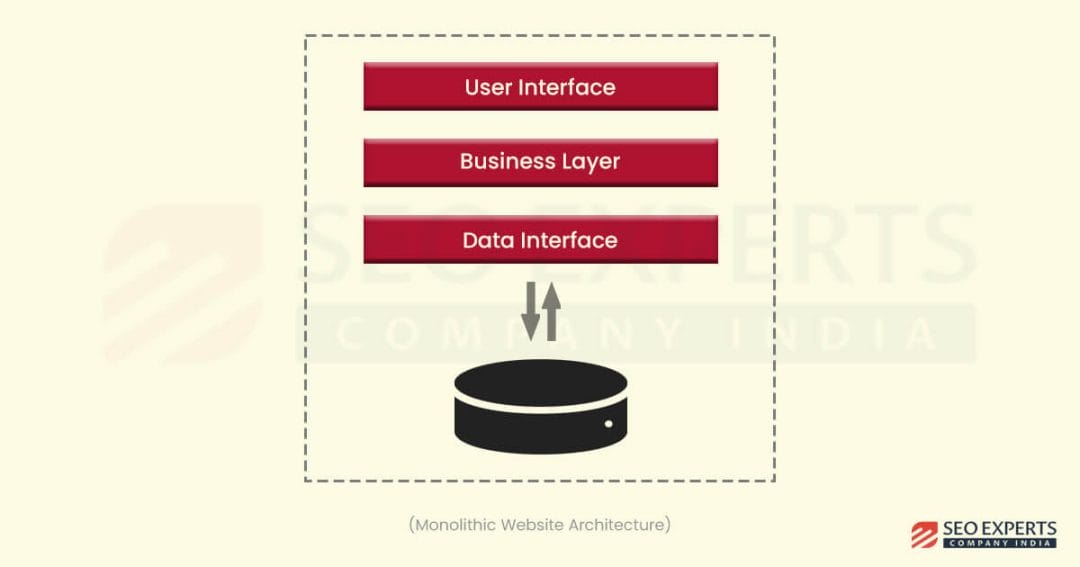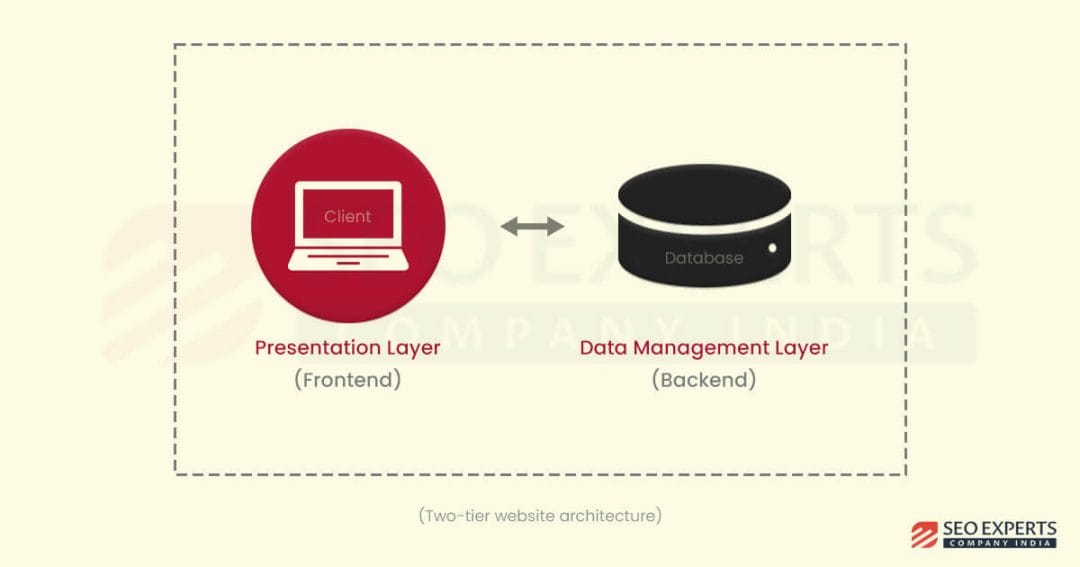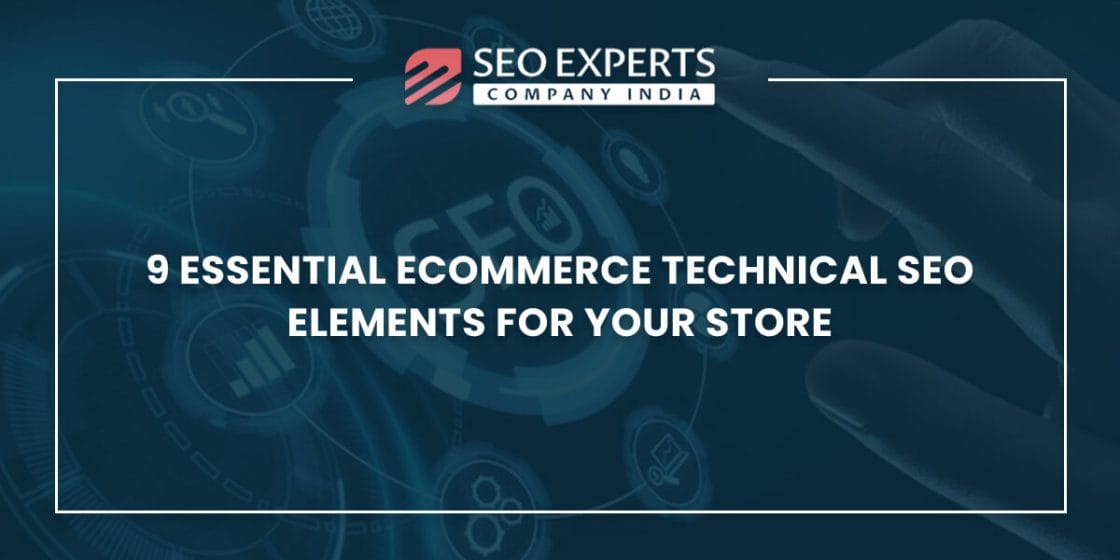You have probably come across the term “ecommerce website architecture” more than once if you are stepping into the world of online selling or are already a seasoned player. Trust us; it’s not just another technical term thrown around in the digital market– website architecture is the backbone of your online store.
We have been in the e-commerce game for a while and assure you that a well-thought-out website architecture can make or break your online success. It’s not just about having an attractive website (though that definitely helps), but it’s about creating a smooth experience for your customers from the moment they land on your homepage to the final click of the checkout button.
Let’s jump straight into the article to learn about different architectures for ecommerce websites, their importance, and insider tips on optimizing website architecture for search engines.
What is an Ecommerce Website Architecture?
Ecommerce website architecture is the complete layout and design of your online store. It involves organizing your website in a way that makes it easy for customers to find what they’re looking for and for search engines to crawl and index your pages.
Every part that plays a role in providing a smooth user experience falls under the website architecture. It incorporates all the elements, starting from the homepage, product pages and shopping cart to user experience, navigation, and website functionality.
Performance, scalability, and flexibility should be your top priorities while building your ecommerce website architecture. This means your website should handle high traffic volumes and numerous transactions without slowing down and easily incorporate new features and updates as your business evolves.
How Does Website Architecture Help Improve Ecommerce SEO?
We firmly believe that “A well-structured website architecture is the foundation of a successful online store.” Besides providing a smooth user experience, here are the key advantages of an e-commerce website architecture:
- Improves SEO performance: Your ecommerce website’s architecture forms the backbone of your SEO strategy. A well-structured architecture with properly organized categories, optimized URLs, and efficient internal linking helps search engines crawl, index, and rank your site effectively.
- Enhances user experience: A carefully designed website architecture ensures smooth navigation for the visitors. It helps them quickly find products, navigate different pages or categories, and complete purchases. This leads to enhanced website performance and better user experience.
- Flexibility and scalability: As your business grows, so shall your website. An effective architecture allows for scalability as your business grows. It helps accommodate new products, categories, and features without compromising performance or user experience.
- Ensures security: Protecting your customers’ sensitive information is paramount in e-commerce. A secure architecture with proper encryption and data protection safeguards your customers’ data and also builds trust and credibility for your brand.
Types of Ecommerce Website Architecture
In order to know which architecture is best for your online store, it is essential to understand the different types of website architectures available for e-commerce websites. Let’s dive in to understand each of them one by one.
Monolithic Website Architecture
Monolithic website architecture for an ecommerce site refers to an approach where all the different parts of the website, like the user interface, business logic layer, and data access layer, are packed together in a single application.
- User interface (UI): The frontend/ presentation layer/ client-side.
- Business logic layer: Handles processing and management of data and business rules within a website (part of the backend).
- Data access layer: The data access code communicates the request to the database.
Monolithic architecture is praised for its simplicity because everything is within a single codebase. On the contrary, scaling a monolithic eCommerce website can be tricky, as any modifications or improvements often require extensive changes to the entire codebase, which can introduce complexities.
While monolithic architecture may be suitable for smaller ecommerce platforms due to its simplicity, it’s essential to consider future growth and scalability carefully.
Advantages of monolithic architecture for eCommerce websites:
- Simple Architecture: Monolithic architecture is straightforward, which makes development easier.
- Easy Communication: Since all modules are within the same application, communication between different parts of the system is easy and efficient.
- Cost-Effective: Monolithic architectures can be cost-effective for smaller projects or startups, as they require fewer resources to set up and manage.
- Proficiency: Many developers are familiar with monolithic architectures, making it easier to find resources and expertise for development and maintenance.
Disadvantages of monolithic architecture for eCommerce websites:
- Poor Scalability: The entire application has to be scaled together for monolithic architecture, potentially leading to performance issues and increased costs.
- Less Flexible: Making changes or introducing new features can be difficult, as modifications to one part of the application may impact other components.
- Maintenance Complexity: Maintenance tasks, such as debugging and upgrading, can be complex and time-consuming due to the interconnected nature of the architecture.
Microservices Website Architecture
In a microservices architecture, the application is divided into small and independent services. In the context of ecommerce websites, each service performs a specific function, such as product catalog, shopping cart, checkout process, user management, or payment processing. These microservices operate independently and communicate with each other through APIs (Application Programming Interface) for smooth functioning.
In simple terms, microservices architecture breaks down your website into smaller, more manageable parts, making it more flexible, scalable, and efficient.
Advantages of microservices architecture for eCommerce websites:
- Easy Scalability: Individual components can be scaled independently without affecting the entire system’s performance.
- Flexible Nature: Because of the independent nature of components, it is easier to deploy updates in the microservices architecture.
- Improved Error Control: Since each service operates independently, issues in one service are less likely to affect the entire system. This makes identifying and fixing problems easier without disrupting the whole e-commerce platform.
Disadvantages of microservices architecture for eCommerce websites:
- Complex Implementation: Microservices architecture is difficult to implement due to separate services and their interactions.
- Expensive: The development, maintenance, and infrastructure costs are high.
Two-tier website architecture
As the name suggests, two-tier website architecture for ecommerce websites refers to a structure where the website is divided into two main layers:
- Presentation layer (frontend): The presentation tier or client interface tier is what users interact with directly, including product pages, category listings, shopping cart functionality, and the checkout process.
- Data management layer (backend): The data management tier handles storage, retrieval, and database data such as product information, customer data, order details, and inventory management.
Advantages of two-tier architecture for eCommerce websites:
- Enhanced User Experience: Two-tier architecture separates the presentation layer from the data management layer, reducing server load and allowing a more responsive user experience.
- Improved Performance: The separation of frontend and backend components allows for optimized handling of user interactions, website traffic and data processing, contributing to improved performance.
- Cost efficient and easy development: Two-tier architecture is cost-efficient, easy to develop, understand and work with.
Disadvantages of two-tier architecture for eCommerce websites:
- Limited scalability: Two-tier architecture becomes challenging to scale as the business and number of visitors start to grow.
- Restricted adaptability: Modifications and changes in the database are restricted due to dependencies between the components.
- Security risks: It lacks an extra layer for protection and validation, creating security vulnerabilities if not properly managed.
Three-tier Website Architecture
If you are following the article, you know that two-tier architecture contains two layers, i.e., the presentation layer and the data management layer. As the name indicates, “three-tier website architecture” involves an extra “application layer” in addition to these two components present in two-tier website architecture.
This intermediate application layer or business logic layer handles tasks such as processing user requests, managing sessions, and implementing business rules. Additionally, it facilitates communication between the presentation and data layers to ensure the smooth operation of the ecommerce website.
A key feature of this architecture is that each layer operates independently on separate servers.
Advantages of three-tier architecture for eCommerce websites:
- Better scalability: It allows better scalability as each layer can be scaled independently to accommodate growing traffic and user interactions.
- Improved security: With the separation of layers, sensitive data can be stored and managed separately from user-facing components, enhancing overall website security.
- Flexible architecture: Three-tier website architecture allows easy adaptation to changes and upgrades without disrupting the entire system.
- Faster performance: Due to separate layers and servers, three-tier architecture results in faster page load times and provides a better user experience, improving overall performance.
- Consistent availability: In a three-tier architecture, even if the server goes down, cached data can still be accessed, ensuring uninterrupted availability for users.
Disadvantages of three-tier architecture for eCommerce websites:
- Complex implementation: Three-tier architecture is complex to implement and manage compared to simpler architectures. It can be challenging to ensure efficient communication between different layers, leading to development delays.
- Higher costs: Setting up a three-tier architecture involves higher initial costs than simpler architectures. Additional hardware, software, and infrastructure may be required to support distinct layers, leading to an increase in upfront investment for the ecommerce website.
Composable Website Architecture
Composable architecture follows an approach where the application is divided into small independent services that are interchangeable. Because they are interchangeable, therefore, these independent services can be combined and assembled into various configurations to serve the unique requirements of an ecommerce platform.
To explain it in non-technical terms, you can think of composable architecture as building a website with LEGO bricks. Each component, such as product listings, checkout process, user authentication, etc., is like a LEGO piece that can be individually developed and then assembled to form the complete website. This approach allows for greater flexibility and scalability because components can be added, removed, or modified without affecting the entire website (same as your LEGO structures).
Advantages of composable architecture for eCommerce websites:
- Flexible to changes: It enables quick changes and adjustments to match the business needs at any given time.
- Easy Updates: Interchangeable components of the architecture allow easy and faster updates.
- Better Scalability: Independent services facilitate better scalability.
- Cost efficiency: Reduces development costs by reusing and repurposing existing components rather than building everything from scratch.
Disadvantages of composable architecture for eCommerce websites:
- Complexity: Managing a number of interchangeable components can introduce complexity.
- Implementation challenges: Needs strong implementation and maintenance strategies to make sure different components interact without any complications.
Headless Website Architecture
Headless architecture refers to a design approach where the frontend presentation layer (the “head”) and the backend business logic layer (the “body”) are separated from each other.
In simpler terms, imagine a mannequin where the head (representing the frontend) and the body (representing the backend) are separate pieces. In a headless architecture, these pieces are detached, allowing businesses to use different technologies or platforms for each part independently.
Practically, this means that the frontend can be developed using modern web technologies like Vue.js or Angular, while the backend can be powered by specialized eCommerce platforms like Shopify, Magento, or WooCommerce.
Advantages of headless architecture for eCommerce websites:
- Efficient Performance: Separating the frontend and backend improves website performance.
- Expanded Reach: Headless architecture allows businesses to deliver consistent brand experiences across multiple channels, including websites, mobile apps, smartwatches, etc., thereby expanding their reach.
- Scalability: Headless architecture offers scalability benefits, as each component can be scaled independently to handle changes in traffic or accommodate growth (especially during peak seasons).
- Security: Headless architecture offers extra security because if there’s a data breach or cyberattack, it won’t affect the entire system due to separate frontend and backend layers.
Disadvantages of headless architecture for eCommerce websites:
- Development Complexity: Implementing a headless architecture requires more development effort and expertise compared to traditional eCommerce setups.
- Higher Initial Cost: Building and maintaining separate frontend and backend systems can be more expensive upfront, as it may require additional resources, tools, and infrastructure to manage the architecture effectively.
- Requires Expertise: Training and education may be necessary to ensure everyone understands how to effectively work within a headless environment.
SaaS
SaaS or Software as a Service is a website architecture for eCommerce platforms, where the eCommerce functionality is provided as a service through a cloud-based software solution. Basically, SaaS website architecture for eCommerce is like renting a fully equipped store instead of building one from scratch. Businesses subscribe to a cloud-based platform that provides all the tools and features needed to run an online store, like product listings, checkout, and payment processing.
Overall, SaaS platforms are suitable for small to medium-sized businesses looking for cost-effective solutions with minimal upfront investment and less technical expertise.
Advantages of SaaS architecture for eCommerce websites:
- Cost-Effective: SaaS platforms typically operate on a subscription basis, eliminating the need for large upfront investments in software licenses or infrastructure.
- Easy Implementation: SaaS platforms often come with pre-built templates, integrations, and user-friendly interfaces for easy setup and implementation process.
- Maintenance and Updates: SaaS providers handle maintenance, updates, and security patches for the eCommerce platform, reducing the burden on businesses’ IT teams.
- Quick Accessibility: With SaaS eCommerce platforms being cloud-based, businesses can access their eCommerce backend from anywhere with an internet connection, enabling remote management.
Disadvantages of SaaS architecture for eCommerce websites:
- Customization Limitations: While some level of customization is possible, SaaS platforms may have limitations, restricting businesses with highly specific requirements.
- Data Security Concerns: Storing sensitive business and customer data on a third-party server may raise security concerns.
- Dependence: Businesses relying on a SaaS platform are dependent on the provider’s reliability and availability.
- Limited Control: Businesses using a SaaS platform may have limited control over the underlying infrastructure and software configuration, limiting their ability to address specific requirements.
Time-tested Tips to Optimize Your Ecommerce Website’s Architecture for SEO
By far, you have gained basic knowledge about the different types of architectures for ecommerce websites. Now, let’s talk about something equally crucial: optimizing your website’s architecture for SEO. Just like selecting the right architecture sets the foundation for your online store, optimizing it ensures that your site stands out and reaches your target audience effectively.
To help you in this endeavor, we are sharing some time-tested strategies we’ve used for our ecommerce clients that will elevate your website’s visibility, putting it right where your customers can easily find it.
Strategic Keyword Research and Placement
While performing keyword research for ecommerce, think like your customers. What terms would they use to find your products? Use tools like Google Keyword Planner, Ahrefs, or SEMrush to identify target keywords. When selecting your keywords, aim for the ones with higher search volume and low competition.
After identifying and selecting, strategically incorporate your target keywords into your URLs, page titles, headings, and product descriptions to attract the right audience.
Categorize your Keywords
Plan your keyword strategy and group your target keywords according to product names and category. This simplifies the process of selecting the best relevant keywords for your eCommerce website. For instance, if you’re running a fashion ecommerce store, categorizing keywords like “men’s shoes” or “summer dresses” under their respective product categories can help you quickly identify the best keywords for each product.
Plan and Review your Website’s Architecture
When you walk through a physical store, you expect products to be categorized logically, right? Apply the same logic to your website. Organize products into categories and subcategories based on their relevance and similarity. This hierarchical structure helps users find what they’re looking for and also aids search engines in understanding your site’s organization.
Next, take the time to map out the connections between each page, ensuring that every link is strategically placed. In the end, you should have a visual overview of your entire website, experiencing the shopper journey from start to finish.
Use Relevant and Concise URLs
We advise you to keep your URLs concise, relevant, and descriptive, as the longer ones can confuse both users and search engines. Using hyphens to separate words and including relevant keywords whenever possible is recommended. This practice makes it easier for search engines to crawl and understand the content of your pages.
Example of a descriptive and relevant URL, clearly indicating the category, subcategory, and specific product:
“https://www.examplestore.com/womens-clothing/dresses/summer-maxi-dress”
Category- womens clothing
Subcategory- dress
Product- summer maxi dress
Incorporate Strategic Internal Linking
Crafting an effective internal linking strategy for e-commerce involves evaluating the website architecture, navigation, and hierarchy. The goal is to make it easy both for the search engines and users to find their way from the homepage to product pages. Start by figuring out which pages and keywords are most important based on your business objectives, user search intent, and audience demand.
Then, map out the architecture and link the homepage to main category pages and subcategory pages with descriptive anchor text. Make sure that your category pages link to relevant subcategories, and that product pages link to related products or categories.
This approach effectively guides users and search engines through your site, improving overall navigation, crawlability, and search engine rankings.
Utilize Canonical Tags
Based on the data, duplicate content is the most critical website SEO issue that negatively impacts your search engine rankings. So, if your e-commerce website has duplicate content issues (high chances you might have them), we advise you to use canonical tags to specify the preferred version of the page.
Canonical tags communicate to Google the main URL for a page, ensuring it’s recognized as the primary version and avoiding any harm from duplicate content.
Implement Schema Markup
Schema markup or structured data markup is a machine-readable format that provides a clear map to search engines, allowing them to easily understand the content of your page.
One of the most popular types of structured data markup for ecommerce SEO is the “Product” schema. Using this markup, e-commerce websites can offer comprehensive product details, such as name, description, price, availability, and more. Furthermore, schemas like “Review” and “Rating” are commonly utilized to display user reviews and ratings directly in search results, enhancing the visibility and credibility of products online.
We recommend you determine the schema types most relevant to your products and content and implement them to drive more organic traffic to your site.
Conduct Site Audits
Regular site audits have always been our top priority because we believe that SEO is not a one-and-done task. Ecommerce site audits help find any flaws that might be affecting the website’s functionality and identify any issues or areas for improvement. You can monitor key metrics such as crawl errors, indexing status, and organic traffic to identify and address any SEO issues promptly.
Wrapping Up
In summary, the backbone of any successful eCommerce site lies in its website architecture. This architecture is the foundation upon which your ecommerce website stands, influencing everything from user experience to search engine visibility.
With 12+ years of expertise and a proven track record in eCommerce solutions, we understands what it takes to elevate your online store above the competition. Our team of skilled professionals knows how to design and optimize websites that look great and perform exceptionally well in search engine rankings.
Want to take your eCommerce business to new heights? Reach out to us at the earliest. Let us put our winning strategies to work for you and transform your brand into a standout sensation.











